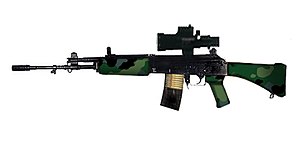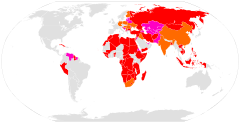| INSAS rifle | |
|---|---|
 INSAS Assault rifle | |
| Type | Assault rifle |
| Place of origin |
|
| Service history | |
| In service | 1998–present |
| Used by | See Users |
| Wars |
Kargil War Nepalese Civil War |
| Production history | |
| Designer | ARDE |
| Manufacturer | Ordnance Factories Board |
| Variants | See Variants |
| Specifications | |
| Mass |
3.2 kg empty 4.65 kg loaded |
| Length |
960 mm (37.8 in), 750 mm (29.5 in) w/stock folded |
| Barrel length | 464 mm (18.3 in) |
|
| |
| Cartridge |
5.56x45mm INSAS 5.56x45mm NATO 5.56×30mm MINSAS |
| Action | Gas-operated, Rotating bolt |
| Rate of fire | 600 rounds/min |
| Muzzle velocity | 900 m/s (2,953 ft/s) |
| Effective firing range | 500 Meters |
| Feed system | 20/30-round detachable box magazine |
| Sights |
In-built Iron sights Plate for attaching various scopes made by Ordnance Factory Board |
INSAS (an abbreviation of Indian Small Arms System) is a family of infantry arms consisting of an assault rifle, a light machine gun and a carbine. It is manufactured by the Ordnance Factories Board at Ordnance Factory Tiruchirappalli, Small Arms Factory Kanpur and Ichapore Arsenal. The Insas Assault Rifle is the standard infantry weapon of the Indian Armed Forces.
History[]
With the 7.62 mm semi-automatic rifle becoming obsolete in the 1980s, the Government of India's Ordnance Factories Board began to develop the INSAS,[1][2] incorporating features from several contemporary rifle designs. Although largely based on the AKM, the INSAS has a number of differences, making it a unique weapon.
During the late 1980s, the Indians expressed interest in purchasing (and possibly manufacturing under license), an East German-designed AK chambered for the 5.56x45mm cartridge.[3] The deal ultimately fell through.
The INSAS system was originally planned to have three component weapons: a standard rifle, a carbine, and a squad automatic rifle (LMG), all chambered for 5.56x45mm NATO ammunition. In 1997 the rifle and LMG were ready for mass production, and in 1998 the first Indian army units were observed armed with INSAS rifles for the Republic Day Parade. At least 300,000 INSAS rifles are in service with the Indian army; some of these have seen action in Indo-Pakistani conflicts.
Design[]

A soldier training with the INSAS rifle.
The INSAS rifle is based on the Kalashnikov AK-47 action with modifications. The basic gas-operated action (long stroke gas system, rotating bolt, and stamped steel receiver) is of the Kalashnikov pattern. The gas system is fitted with a manual gas regulator similar in design to that found on the FN FAL as well as a gas cutoff. The charging handle is positioned on the left side of the forearm; it is similar in position and design to the German HK G3 rifle.
The selector/safety switch is located on the left side of the receiver above the pistol grip, which allows single shots and three-round bursts. The rifle is fitted with a side-folding carrying handle, and either a solid or side-folding metal buttstock. Furniture is made of polymer with the stock using the butt-plate from the 1A SLR (Indian version of the FN FAL) rifle. Standard magazines are made from semi-translucent polymer and contain 20 rounds. Longer 30-round magazines of similar design are available for the INSAS LMG but can also be used in the rifle. The sights consist of a hooded front, mounted on top of the gas block, and a diopter rear, mounted on the receiver cover. The flash suppressor is shaped to accept NATO-standard rifle grenades. It can be fitted with an AKM-style multipurpose knife-bayonet.
The assault rifle version has semi-auto and 3-round burst modes much like the US M16A2. Derived from the INSAS weapon systems, the INSAS Excalibur Mark-I is ergonomically designed with a folding butt and can be fitted with 20 and 30-round magazines. It is also fitted with a Picatinny rail for mounting of opto-electronic devices. The latest variant of the INSAS has semi-automatic, 3 round bursts and full automatic fire modes.
An under-barrel grenade launcher and bayonet have been recently been issued for use with the INSAS, which are also compatible with the AK-47s used by paramilitary forces.
Design Issues[]
The INSAS saw combat during the 1999 Kargil conflict with Pakistan. According to the Times of India, the rifle encountered some reliability problems in the very cold climate in which the conflict took place. Due to the cold weather, the rifle would jam occasionally and the polymer magazines would crack.[4] There were also cases where the rifle would fire on full automatic, while in three-round burst fire mode.[4] According to the manufacturers, these problems have been fixed.
After King Gyanendra seized power, relations between India and Nepal cooled, with India refusing to grant military aid and also blocking the way for weapons from other countries. There were reports that the rifle malfunctioned in a gunbattle with Maoist insurgents in the battle of Kalikot, leading to a rare heavy loss of Nepalese army side.[5] This was refuted by the Indian embassy in Nepal, trials conducted before the Nepalese Army showed that the rifle was satisfactory and that the malfunctions had been due to poor handling and improper cleaning of the rifle by Nepalese soldiers. Nepalese soldiers were still not satisfied as the rifle malfunctioned when used extensively for prolonged periods at war or during trainings.[5] These drawbacks were said to have been fixed after the Kargil Conflict in 1999.[citation needed]

INSAS Rifle with newly adopted black furniture
Variant & Developments[]

INSAS light machine gun
- INSAS Standard rifle (5.56 mm) issued to Indian Army & Paramilitary, with folding and fixed stock variants, fires in semi-automatic and three round burst, much like its American counterpart the M16A4. An assault variant is also manufactured with full auto fire mode along with semi & three burst mode, and is used by the Indian Army.
- INSAS (Folding stock) (5.56 mm) identical to the standard issue INSAS in all areas except that the fixed stock is replaced with a folding stock to shorten the overall length and that it does not include a full-auto fire mode. It is most suitable for combat from ICV and in a paratrooper role.[6]
- INSAS LMG 5.56 mm INSAS (folding and fixed stock variants) - An Indian version of the Squad Automatic Weapon (SAW). Incorporated for suppressive and cover fire for troops. Barrel is designed for long and continuous fire. It has a auto fire mode with 30 round feed capacity along with a bipod. Meant to replace the old Bren LMG.
Kalantak Micro Assault Rifle 5.56mm
- KALANTAK 5.56 mm micro assault rifle (under-going user trials), - The Kalantak Micro Assault Rifle is a gas operated automatic, air cooled, folding stock Rifle for CQB & Personnel Defence Weapon roles. The weapon uses the same ammunition (5.56x45mm) as used in the standard rifle/ LMG, thus reducing the logistics problems with utilizing different kinds of ammunition for different weapon roles. Its design and mechanism are simple (following the Kalashhikov tradition) and because it has NATO standard Picatinny rails attached, it has the capability to accommodate the various modern optical sights like the Trijicon ACOG, EOTech series holographic sights, or the Aimpoint red dot sight, available on the international market. Due consideration has been given for reliability, ergonomics and aesthetics throughout the design process of the weapon. The furniture items will be subjected to continual improvement from human engineering point of view.[7]
- Modern Sub Machine Carbine - A submachinegun in the INSAS family, which is chambered for the proprietary 5.56×30mm MINSAS ammunition designed specially for the gun. The magazine is in the pistol grip as in the Uzi. This weapon has passed two phases of trials by the Army, third and final trial has been conducted in December 2009.[8]
Replacement[]
Due to the design issues associated with the INSAS, the Indian Army released a request for proposals (RfP) for a replacement rifle. The original RfP went out to 34 manufacturers. By November 2012, the five companies remaining were Sig-Sauer, ČZUB, Beretta, Colt, and Indumil. The gun must have at least two different barrel lengths, a max weight of 3.6 kg (7.9 lb), be able to mount an integrated grenade launcher, and have the ability to load and fire locally-produced ammunition. 65,000 rifles will be bought directly from the foreign vendor, with Ordnance Factory Board then producing 113,000 rifles domestically after getting transfer of technology from the vendor. The weapon is also to fill light machine gun and sniper rifle roles. The Army wants 16,000 machine guns and 3,500 sniper rifles, both chambered in 7.62x51 mm NATO with a 1 km (1,100 yd) effective range. Field evaluation trials began in early 2013, with fielding planned for mid 2014.[9][10] The Indian Army is expected to begin high-altitude winter trials for the rifles in the Leh district in mid-2013, with summer trials to begin in Thar Desert in 2014. The five contenders are the Beretta ARX-160, the CZ-805 BREN, the Indumil Galil ACE, the Sig 551, and the Colt Combat Rifle, a variant of the M16A1.[11]
Users[]
 Bhutan: Used in small numbers by the Royal Bhutan Army.[12]
Bhutan: Used in small numbers by the Royal Bhutan Army.[12] India: Assault rifle and LMG variants were adopted by Indian Armed Forces & Indian Paramilitary Forces.[13][14]
India: Assault rifle and LMG variants were adopted by Indian Armed Forces & Indian Paramilitary Forces.[13][14] Nepal: 23,000 INSAS rifles supplied to the Nepalese Army at a 70% subsidy price.[5]
Nepal: 23,000 INSAS rifles supplied to the Nepalese Army at a 70% subsidy price.[5] Oman: The Royal Army of Oman will start using the INSAS rifles as per a defence agreement signed in 2008 between India and Oman.[15][16]
Oman: The Royal Army of Oman will start using the INSAS rifles as per a defence agreement signed in 2008 between India and Oman.[15][16]
See also[]
Notes[]
- ↑ http://ofbindia.gov.in/index.php?wh=Weapons&lang=en
- ↑ http://news.oneindia.in/2007/03/19/oft-develops-gen-x-weapons-1174286532.html
- ↑ Edward Clinton Ezell, Kalashnikov - The Arms and the Man, Collector Grade Publications, Canada[page needed]
- ↑ 4.0 4.1 INSAS not performing to optimum level: Army.
- ↑ 5.0 5.1 5.2 "Indo-Nepal war of words over INSAS rifles". 2005-08-22. http://news.indiamart.com/news-analysis/indo-nepal-war-of-wo-10160.html. Retrieved 2010-03-09.
- ↑ Ordnance Factory Board
- ↑ Ordnance Factory Board
- ↑ Modern Firearms - MSMC
- ↑ India Seeks INSAS Assault Rifle Replacement - Armedforces-International.com, November 29, 2012
- ↑ Army to replace INSAS with new assault rifles - Economictimes.com, December 20, 2012
- ↑ India to put assault rifle contenders through winter trials - Janes.com, 4 August 2013
- ↑ [1]
- ↑ Modern Firearms: INSAS
- ↑ Hogg, Ian (2002). Jane's Guns Recognition Guide. Jane's Information Group. ISBN 0-00-712760-X.
- ↑ [2]
- ↑ Oman army all set to use India’s INSAS rifles - Hindustan Times
External links[]
| Wikimedia Commons has media related to INSAS rifle. |
- INSAS: INdian Small Arms System
- Ordnance Factory Board homepage
- Ordnance Factory Board page on INSAS
- Ordnance Factory Board page on Excalibur
- Ordnance Factory Board page on MINSAS
- Ordnance Factory Board page on Kalantak
- Ordnance Factory Board page on AMOGH
- Modern Firearms
| |||||||||||||||||||||||||||||||||||||||||||||||||||||||||||||
| |||||||||||||||||||||||||||||||||||||||||||||||||||||||||||||||||||||||||||||||||||||||||||||||||||
| ||||||||||||||||||||||||||||||||||||||||
The original article can be found at INSAS rifle and the edit history here.
